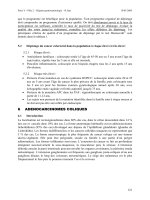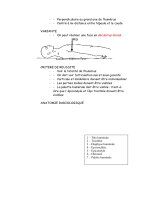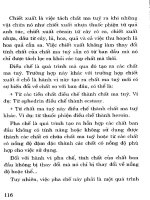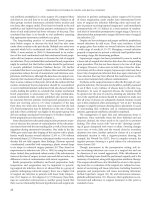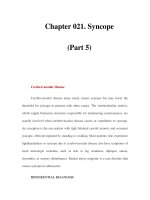Neurology 4 mrcp questions book - part 5 potx
Bạn đang xem bản rút gọn của tài liệu. Xem và tải ngay bản đầy đủ của tài liệu tại đây (25.28 KB, 14 trang )
a- Carpo-pedal spasm is more common in children than adults.
b- In adults, stridor is uncommon.
c- Seizures are usually resistant to antiepileptic therapy.
d- The cornerstone in the treatment of pseudohypoparathyroidism is calcium
supplement.
e- Regular follow up is needed with measurement of serum calcium.
Q37: Cushing syndrome in general, all of the followings are true, except:
a- Obesity is the commonest sign.
b- Hypertension is absent in 25% of cases.
c- Prominent hyper-pigmentation is in favor of an ectopic ACTH secreting source.
d- Depression is the commonest psychiatric manifestation.
e- Muscle biopsy will show type I fiber atrophy.
Q38: In the diagnosis of Cushing syndrome, all of the followings are true, except:
a- Acclimatization to hospitalization for 48 hours is very important before hand.
b- 24 hours urinary free cortisol or overnight low dose dexamethasone suppression
test are the preferred initial screening tests.
c- Unfortunately dexamethason cross reacts with the cortisol immunoassay.
d- Chronic alcoholism sometimes exactly resembles Cushing's syndrome clinically
and biochemically.
e- Suppressed ACTH levels indicate an adrenal tumor.
Q39: Treatment of Cushing syndrome, all of the followings are true, except:
a- In pituitary dependent disease, trans-sphenoidal surgery is the preferred option.
b- If treated by bilateral adrenalectomy, the pituitary should be irradiated to prevent
the development of Nelson's syndrome.
c- Medical treatment is usually given in the way to prepare the patient for surgery.
d- Adrenal carcinoma should be removed surgically and the tumor bed is irradiated
and then the patient is given the drug o'p'DDD.
e- Without treatment, the 5 year survival rate is 90%.
Q40: Causes of apparent hyperaldosteronism, all of the followings are true,
except:
a- Treamtent with carbenoxolone.
b- 11 deoxycorticosterone secreting tumors.
c- Liddle's syndrome.
d- Ectopic ACTH syndrome.
e- Glucocorticoides suppressible hyperaldosterosnism.
Q41: In primary aldosteronism, all of the followings are true, except:
a- Hypertension is almost always present and is the commonest presenting feature.
b- Serum potassium is normal up to 70% of cases at the time of diagnosis.
c- Of all causes, only Conn's adenoma can be treated by surgery.
d- Spironolactone is very effective in normalizing the blood pressure and biochemical
abnormalities in the majority of cases.
e- Leg edema is very common.
Q42: Pheochromocytoma, all of the followings are true, except:
a- May be part of specific syndromes.
b- Predominantly elevated noradrenalin suggests either a large adrenal tumor or an
extra adrenal tumor.
c- Weight loss indicates associated diabetes mellitus.
d- Postural hypotension may be seen.
e- The rise in blood pressure may occur during urination.
Q43: Addison's disease, all of the followings are true, except:
a- The commonest cause is autoimmune adrenalitis.
b- Vitilligo is seen in 20% of cases.
c- Hyperglycemia indicates an associated type I diabetes.
d- Postural hypotension is indicates glucocorticoids rather than mineralocorticoids
deficiency.
e- It is a common condition with an incidence of 8000 new case/ million of
population.
Q44: Congenital adrenal hyperplasia, all of the followings are true, except:
a- The commonest cause is 21 alpha hydroxylase deficiency.
b- All cases are autosomal recessive.
c- Causes ambiguous genitalia in females and precocious pseudopuberty in males.
d- 11 beta and 17 alpha hydroxylases are associated with hypotension.
e- The condition can be prevented by appropriate prenatal diagnosis and giving
dexamethason to the pregnant mother.
Q45: Drug induced gymecomastia may be due to all of the followings, except:
a- Digoxin.
b- Cimetidin.
c- Stilboestrol.
d- Spironolactone.
e- Ameloride.
Q46: In polycystic ovarian syndrome, all of the followings are true, except:
a- Insulin resistance is though to be the central key in the pathogenesis.
b- There is a mild elevation in serum prolactin.
c- There is a mild elevation of serum androgens.
d- There is an elevated blood estron level.
e- FSH: LH ratio is more than 3.5:1.
Q47: In the assessment of hirsutism in a female, all of the followings are
important clues to the underlying cause, except:
a- As idiopathic hirsutism is the commonest cause, so being an Asian or
Mediterranean are important clues to it.
b- High levels of androgens that don’t suppress with steroids or estrogens are very
important clues to ovarian or adrenal tumors.
c- Being a highly trained athletic female may suggest an exogenic androgen intake.
d- Mooning of the face with obesity and striae may be a clue to Cushing's syndrome.
e- Family history of hirsutism is not that important.
Q48: MEN type I and type II, all of the followings are true, except:
a- Due to mutation in MENIN gene on chromosome 11 in type I.
b- Symptomatic hypercalcemia is the commonest presenting feature in type II.
c- Family history of one relevant endocrine tumor may be present.
d- Pheochromocytomas in type II are bilateral in 70% of cases.
e- Carcinoid syndrome is uncommon in type I.
Q49: Carcinoid tumors and syndromes, all of the followings are true, except:
a- The commonest site is the ileum for carcinoid tumors.
b- May present as appendicitis.
c- The long term prognosis is excellent in the majority.
d- Carcinoid syndrome may present as right sided heart failure.
e- Cramping abdominal pain and diarrhea with flushing and wheeze are the
commonest presenting features of carcinoid tumors.
Q50: In pancreatic endocrine tumors, all of the followings are true, except:
a- Somatostatinomas may presents with gall stones and diabetes.
b- Glucagonomas may present with anemia and weight loss.
c- Gastrinomas may present with steatorrhea.
d- VIPOmas may present with watery diarrhea and profound hyperkalemia.
e- Insulinomas may present with dizzy spells.
End of part of endocrinology
Chapter VIII / Diabetes Mellitus
Q1: Diabetes mellitus may be associated with many genetic syndromes, all of the
following associations are true, except:
1- Myotonia dystrophica.
2- Down's syndrome.
3- Lipodystrophy.
4- Friedriech's ataxia.
5- Nesidiolastosis.
Q2: Type I diabetes mellitus, all of the followings are true, except:
1- It is a T cell mediated immunological disease.
2- There is a mononuclear cell infiltration of the pancreas causing insulinitis.
3- There is an association with HLD B8/DR3 DR4.
4- Concordance rate in monozygotic twins is almost 100%.
5- The disease can be induced to enter a remission by immune suppressed.
Q3: Type II diabetes mellitus, all of the followings are true, except:
1- About 70% of patients are above the age of 50 years at the time of diagnosis.
2- About 10% of the whole population above the age of 65 years has type II diabetes
mellitus.
3- About 80% of females with a history of gestational diabetes will ultimately develop
type II diabetes.
4- Overeating, obesity and under-activity are risk factors for the future development
of type II diabetes.
5- Concordance rate in monozygotic twins is around 50%.
Q4: Type 2 diabetes mellitus has been shown to be associated with many single
gene mutations, all of the following gene mutations are autosomal dominant ,
except:
1- Mutation in hepatocyte nuclear factor 4 alpha gene.
2- Mutation in hepatocyte nuclear factor 1alpha gene.
3- Mutation in glucokinase gene.
4- Mutation in insulin promoter factor gene.
5- Mutation in mitochondrial DNA
Q5: Action of insulin, all of the followings are true, except:
1- Decreases lipolysis.
2- Enhances the action of lipoprotein lipase.
3- Enhances potassium and amino acid entry into cells.
4- Enhances glycogensis and glycolysis.
5- Enhances fatty acid synthesis by the liver
Q6: Oral glucose tolerance test, all of the followings are true, except:
1- Is not used in the routine diagnosis of diabetes mellitus.
2- There should be unrestricted carbohydrate diet 3 days before the test.
3- The patient may be allowed to smoke during the test.
4- The patient should fast overnight.
5- If the 2 hours plasma glucose level was between 7.8-11.1 mmol /L, it is called
impaired glucose tolerance test.
Q7: Diagnosis of diabetes mellitus, all of the followings are true, except:
1- Glycated hemoglobin is not used for the diagnosis.
2- The presence of glycosuria should warrant further investigations and should not be
used as a diagnostic test per se.
3- Ketonuria per se is not pathognomonic for diabetes and may found in normal
people after prolonged fasting or exercise.
4- The fasting blood glucose is always preferred over the random one in the diagnosis.
5- The random blood glucose of more than 11.1 mmol/L on 4 or more occasions is
diagnostic for diabetes mellitus.
Q8: Dietary Management of diabetes, all of the followings are true, except:
1- 50% of type II diabetes will respond initially to diet alone.
2- The total dietary fat better not to exceed 10% of total energy intake.
3- Alcohol should be avoided.
4- Salt restriction is advised.
5- Encourage regular exercises.
Q9: Effects of anti-diabetic agents, all of the followings are true, except:
1- Glyclizide has no effect on lipid profile.
2- Insuline does not reduce post prandial glycemia.
3- Acarbose has no hypoglycemic effect.
4- Pioglitazone does not raise serum insulin.
5- Metformin does not increase body weight.
Q10: Side effects of anti-diabetic agents, all of the followings are true, except:
1- Metformin carries a risk of lactic acidosis.
2- Chlopropamide may cause SIADH.
3- Rosiglitazone may cause prominent fluid retention.
4- Insulin may cause peripheral edema.
5- Acarbose causes severe constipation.
Q11: Severe hypoglycemia in diabetics may cause all of the followings, except:
1- Vitreous hemorrhage.
2- Cardiac dysrrhythmia.
3- Hyperthermia.
4- Risks of accidents.
5- Stroke.
Q12: Causes of hypoglycemia in diabetics, all of the followings are true, except:
1- Absence of exercises.
2- Unrecognized other endocrine diseases like Addison's disease.
3- Missed, delayed or inadequate meal.
4- Gastroparesis.
5- Factitious and deliberately induced.
Q13: Diabetic ketoacidosis, all of the followings are true, except:
1- Caused by severe and absolute insulin deficiency.
2- Average fluid loss is 6 liters and potassium loss is 350 meq/ L.
3- Any sudden impairment in consciousness during treatment should alert you to the
possibility of brain edema.
4- Sudden gastric dilatation may occur.
5- Leukocytosis indicates infection.
Q14: Complications of diabetic ketoacidosis, all of the followings are true,
except:
1- DIC is common.
2- Confusion, drowsiness and coma is seen up to 10%.
3- Thromboembolism.
4- Acute circulatory failure.
5- ARDS.
Q15: Non ketotic hyperosmolar coma, all of the followings are true, except:
1- Acidosis is not a prominent part of the picture.
2- Hyperosmolarity is a must.
3- Thromboembolic complications are common.
4- 1% mortality rate.
5- The condition usually affects elderlies with previously undiagnosed diabetes.
Q16: Diabetic retinopathy, all of the followings are true, except:
1- Microaneurysms are the first ophthalmoscopic sign in background retinopathy.
2- Hard exudates are characteristic.
3- Prominent soft exudates indicate an advanced retinopathy state or an associated
hypertension.
4- IRMAs (intra-retinal micro vascular abnormalities) mainly indicate a pre-
proliferative stage.
5- Venous loops and beadings are seen mainly in proliferative stage.
Q17: Diabetic peripheral neuropathy, all of the followings are true, except:
1- Variable combination of axonopathy, demyelination and thickening of Shwann cell
basal lamina.
2- Overall, seen in 50 % of cases and usually not that symptomatic.
3- May be associated with Charcot joints.
4- Mainly motor and is irreversible.
5- May cause trophic ulceration in the feet.
Q18: Diabetic nephropathy, all of the followings are true, except:
1- Occurs in 30-35% of type I diabetes but 10-20% of type II diabetes.
2- 50% of diabetic nephropathy patients are type II.
3- Hypertension is very common and may accelerate the course.
4- The nodular glomeruloscleorsis type is much more common than the diffuse type.
5- ACE inhibitors are effective at reducing the rate of progression even in the absence
of hypertension.
Q19: Diabetes and pregnancy, all of the followings are true, except:
1- Ideally, all patients should have pre-pregnancy counseling.
2- Ideally, diabetes should be controlled before pregnancy rather than during the
course of pregnancy.
3- The objective of good diabetic control is to decrease the fetal congenital anomalies.
4- Oral hypoglycemics are useful in the management.
5- Insulin requirement varies through out the course of pregnancy.
Q20: Surgery in diabetics, all of the followings are true about preoperative
evaluation, except:
1- Pre-operative cardiovascular and renal assessments are very important.
2- Preoperatively, check signs of neuropathy and especially autonomic one.
3- Assess the over all glycemic control by HbA1c.
4- Review the overall treatment and stop metformin and long acting sulphonylureases
prior to the day of surgery.
5- No need for hospitalization in all cases, as the assessment can be done on an
outpatient basis.
END of Diabetes
Chapter IX / Hematology
Q1: Differential diagnosis of iron deficiency anemia, all of the followings are
true, except:
1- Aluminuim toxicity.
2- Beta thalassemia syndromes.
3- Alpha thalassemia syndromes.
4- Lead poisoning.
5- Aplastic anemia.
Q2: Causes of macrocytosis without a megaloblastic bone marrow, all of the
followings are true, except:
1- Myelodysplastic syndromes.
2- Aplastic anemia.
3- Multiple myeloma.
4- Chronic myeloid leukemia.
5- Fish tapeworm infestation.
Q3: Causes of macrocytosis with normal bone marrow, all of the followings are
true, except:
1- Liver disease.
2- Neonatal.
3- Pregnancy.
4- Post –hemorrhage.
5- Myelomatosis.
Q4: Causes of dimorphic blood picture, all of the followings are true, except:
1- A patient with long standing iron efficiency anemia who had received blood
transfusion because of symptomatic coronary artery disease
2- Long standing iron deficiency anemia patient who had received iron therapy before
1 week
3- Celiac disease patient non-compliant with glutin free diet.
4- Bone marrow study of a patient showing characteristic rings in the maturing
erythroid series.
5- A young pregnant lady on long term treatment with phenytoin.
Q5: Sickle cell anemia, all of the followings are true, except:
1- Despite the degree of anemia in the chronic stable state, it is usually rarely
symptomatic,
2- In contrast to beta thalassemia major, blood transfusion is rarely indicated except
probably in crisis or in certain selected patients not in crisis.
3- The target of blood transfusion is to raise the hemoglobine A to 85-90% of the total
hemoglobins and the PCV should be between 30-36 %.
4- Pulmonary infarction-chest syndrome is the commonest cause of death in adults.
5- Stroke in general is seen in 70 % of adults.
Q6: Beta thalassemias, all of the followings are true, except:
1- Hb A2 may be normal or even low in beta thalassemia minor.
2- Regular transfusion is the mainstay in the treatment of beta thalassemia major.
3- Beta thalassemia minor usually comes into light after a failure of oral iron therapy
for a mild hypochromic anemia.
4- Hear failure in beta thalassemia major is only due to iron overload causing
cardiomyopathy.
5- Target cells are seen in peripheral blood film.
Q7: Causes of prominent intravascular hemolysis, all of the followings are true,
except:
1- Falciparum malaria.
2- Clostridia septicemia.
3- Immediate major ABO incompatibility reaction.
4- Paroxysmal nocturnal hemoglobinuria.
5- Hemolytic disease of the new born.
Q8: Hemolytic uremic syndrome (HUS) and thrombotic thrombocytopenic
purpura (TTP)
1- Neurological manifestations are more prominent in TTP.
2- Renal impairment is more prominent in HUS.
3- Skin rash is mainly seen in TTP.
4- Prolonged PT and aPTT occurs in HUS rather than TTP.
5- Vincristin may be used in the treatment.
Q9: Causes of eosinophilia, all of the followings are true, except:
1- Psoriasis.
2- Trichinosis.
3- Treatment with steroids.
4- Hodgkin’s disease.
5- Chronic myeloid leukemia.
Q10: Causes of monocytosis, all of the followings are true, except:
1- Bone marrow recovery from chemotherapy.
2- Sarcoidosis.
3- Myelodysplastic syndrome.
4- Kala-azar.
5- Hairy cell leukemia.
Q11: Causes of neurtropenia, all of the followings are true, except:
1- Racial.
2- Associated viral infections.
3- Hypersplenism.
4- Treatment with carbimazole.
5- Leptospirosis.
Q12: Poor prognostic factors in acute lymphonlastic leukemia, all of the
followings are true, except:
1- Male sex.
2- Age less than 1 year and more than 10 years.
3- CNS involvement at the time of diagnosis.
4- Common ALL type.
5- Very high leukocyte count at the time of diagnosis.
Q13: Which one of the following cytogenetic abnormalities seen in acute
myeoloid leukemia is true:
1-M6 subtype–inv 16
2-M3 subtype–t(15,17)
3-M5 subtype- t( 8,21)
4-M1 subtype- t(1,15)
5-M2 subtype-t ( 2,14)
Q14: AML M3 subtype, all of the followings are true, except:
1- The presence of t(15,17) confers a good prognosis.
2- The genetic defect lies in RARA gene.
3- Treatment with ATRA enhances further differentiation of the promyeloblasts from
its differentiation block site.
4- Almost always of a hypogranular type.
5- Evidence of DIC is present up to 80% at the time of diagnosis.
Q15: Chronic myeloid leukemia, all of the followings are true, except:
1- The absence of Philadelphia chromosome portends a poor prognosis.
2- Treatment with imatinib mesylate will produce an 80% cytogenetic remission.
3- Basophilia is usually the first sign of the accelerated crisis.
4- Associated vitamin B12 deficiency is very common.
5- LAP (leukocyte alkaline phosphatase) score is low.
Q16: Chronic lymphocytic leukemia, all of the followings are true, except:
1- Trisomy 12 is the commonest cytogenetic abnormality.
2- Smudge cells are seen in peripheral blood film with absolute lymphocytosis of
mature looking lymphocytes.
3- Bullous skin rash may be seen.
4- Monoclonal band is seen in some patients on serum protein electrophoresis.
5- Hyperuricemia is common.
Q17: Hodgkin's disease, all of the followings are true, except:
1- LDH is raised and is a useful guide to the bulk of the disease.
2- Usually there is anemia, neutrophilia, thrombocytosis and in some esosinophilia at
the time of diagnosis.
3- Residual masses after treatment are common.
4- Lymphocyte depleted type usually has poor prognosis.
5- There is an association with CMV infection.
Q18: Multiple myeloma, all of the followings are true, except:
1- The ESR is usually very high.
2- 1% is non secretory.
3- Human herpes virus type 8 infection is being increasingly recognized association.
4- Bone scan is usually normal.
5- Serum alkaline phosphatase is usually high a the time of diagnosis
Q19: Features in favor of monoclonal gammopathy of undetermined significance
(MGUS) rather than multiple myeloma (MM) are all of the followings, except:
1- Low level of the paraprotein.
2- The paraprotein remains stable over many months of period of observation.
3- No bone disease.
4- No renal disease.
5- Hypogammaglobulinemia.
Q20: Causes of secondary polycythemia, all of the followings are true, except:
1- Adaptation to high altitude.
2- Pickwikian syndrome.
3- Hemoglobin M disease.
4- Primary hepatocelluar carcinoma.
5- Polycythemia rubra vera.
Q21: Causes of reactive thrombocytosis, all of the followings are true, except:
1- post splenectomy states.
2- post hemorrhage states.
3- post surgical states.
4- post partum states.
5- polycythemia rubra vera.
Q22: Myelodysplastic syndromes, all of the followings are true, except:
1- Seen increasingly in old people but no age is exempted.
2- cytopenias are very common and dysplastic changes in the bone marrow are seen.
3- Up to 40 % will progress to AML.
4- 5q minus syndrome has a relatively good prognosis and is seen mainly in woman.
5- The commonest type is refractory anemia.
Q23: Antiphosopholipid syndrome, all of the followings are true, except:
1- The aPTT is prolonged and does not correct with addition of normal plasma.
2- Addison’s disease can be a complication.
3- Thrombocytopenia and immune hemolytic anemia.
4- Chorea, migraine and transverse myelopathy.
5- There is a bleeding diathesis.
Q24: Von Willibrand disease, all of the followings are true, except:
1- The commonest mild inherited bleeding tendency.
2- DDAVP is contraindicated in type II B.
3- Bleeding time is a useful screening test.
4- Some cases are associated with normal amount of von Willibrand factor antigen.
5- The disease always has an autosomal dominant inheritance.
Q25: Hemophilia A, all of the followings are true, except:
1- 1/3
rd
of cases are kept in the community by fresh new mutations.
2- The PT and the bleeding time are normal.
3- Preferably treated by recombinant human factor VIII concentrate.
4- The prolonged aPTT does correct with addition of normal plasma.
5- Normal activity of factor VIII is 200-300%.
Q26: Idiopathic thrombocytopenic purpura, all of the followings are true except:
1- The presence of splenomegaly may be a clue to chronic lymphocytic leukemia.
2- In adults usually it takes a chronic fluctuating course rather than an acute
monophasic illness.
3- 2/3
rd
of cases will respond to steroid therapy.
4- The bone marrow has a limited role in the diagnosis.
5- In adults the disease is usually preceded by an upper respiratory tract infection.
Q27: Causes of renal impairment in multiple myeloma, all of the followings are
true, except:
1- Hyperuricemic nephropathy.
2- Hypercalcemia and dehydration.
3- Amyloidosis and light chain deposition.
4- Severe and recurrent urinary tract infections and high dose NSAIDS.
5- Treatment with glucocorticoids.
Q28: Bad prognostic sings in multiple myeloma at the time of diagnosis, all of the
followings are true, except:
1- Severe hypoalbuminemia.
2- Plasma cell leukemia.
3- Low serum Beta 2 microglobulin level.
4- Intractable renal failure.
5- Hemoglobin less than 7 g/ dl.
Q29: Multiple myeloma, all of the followings are true, except:
1- High fluid intake is an important part of the management.
2- The commonest paraprotein secreted is IgG.
3- Recurrent chest infections imply immune paresis rather than bone marrow failure.
4- Headache, blurred vision and epistaxis usually indicates hyperviscosity with
paraprotinema of IgA type.
5- Raised serum alkaline phosphatase is common at the time of diagnosis.
Q30: Hairy cell leukemia, all of the followings are true, except:
1- Severe neutropenia and monocytopenia are common and characteristic.
2- It is a rare indolent B-cell lymphoproliferative disorder.
3- The malignant B-cells characteristically carry CD25 and CD103
4- The response to Cladribin is excellent with long term remission is the rule in many
cases.
5- Lymph node enlargement is very common.
Q31: Myelodysplastic syndrome (MDS), all of the followings are true, except:
1- The treatment is still unsatisfactory.
2- Chromosomal analysis frequently reveals abnormalities in chromosomes 15 and
17.
3- The disease is probably more common than acute leukemia.
4- Secondary MDS is seen mainly in patients receiving chemotherapy or radiotherapy
for some reason or another.
5- Macrocytosis is characteristic.
Q32: Immune hemolytic anemia, all of the followings are true, except:
1- The commonest cause is the idiopathic form.
2- The presence of smudge cells on blood film may point to a certain etiology.
3- Direct Coomb’s test detects IgE and complement but not IgA antibodies.
4- A positive direct Coomb’s test requires at least 200 antibodies to be attached to the
surface of RBCs to be positive.
5- There is an association with HIV infection.
Q33: Hereditary spherocytosis, all of the followings are true, except:
1-The commonest abnormalities are seen in beta spectrins and ankyrins.
2-Pigment gall stones are seen up to 50% of cases.
3- Recurrent severe crisis is an indication for splenectomy.
4- 75 % of cases are from fresh new mutations.
5- Coomb’s test is negative.
Q34: G6PD deficiency, all of the followings are true, except:
1- The prematurely released reticulocytes may have normal level of the enzyme.
2- Bite cells and blister cells are seen in peripheral blood film.
3- Hienz bodies are seen only by staining the blood film with a supravital stain.
4- May present as a neonatal jaundice.
5- The African type of deficiency is very severe.
Q35: Magaloblastic anemias, all of the followings are true, except:
1- The blood film cannot differentiate between vitamin B12 and folic acid
deficiencies.
2- Neurological manifestations are in favor of vitamin B12 than folic acid
deficiencies.
3- Serum folate is less useful than red cell folate level.
4- The response to hematinic replacement may precipitate severe hyperkalemia.
5- The response to hematinic replacement is seen even within minutes.
Q36: Features in favor of hemolysis, all of the followings are true, except:
1- Raised serum LDH.
2- Indirect hyperbilirubinemia.
3- Reticulocytosis.
4- Hemoglobinemia.
5- Negative urinary hemosiderin.
Q37: Assessing iron status in iron deficiency anemia (IDA), all of the followings
are true, except:
1- Ferritin is raised in acute phase responses.
2- Plasma iron is raised in liver disease and hemolysis.
3- Serum transferrin levels are low in liver disease and acute phase responses.
4- Transferrin saturation less than 66%is highly suggestive of iron deficiency anemia.
5- Increased serum soluble transferring receptors is very helpful in the diagnosis of
iron deficiency anemia.
Q38: Severe allergic reactions associated with blood transfusions, all of the
followings are true, except:
1- Immediately stop the infusion.
2- Give O2 and salbutamol nebulizer.
3- Give saline wash future blood components.
4- Return the blood unit intact to the blood bank with all other used or unused units.
5- Bronchospasm, angiodema and hypotension are rare.
Q39: Major ABO incompatibility, all of the followings are true, except;
1- Immediately stop the infusion, takedown the unit and the giving set and return it to
the blood bank.
2- Commence IV saline infusion and measure urine input /output.
3- Inform the hospital transfusion department immediately.
4- Treat any DIC.
5- Ensure urine out put of at least 10 ml / minute
Q40: Indication for a thrombophilia screen, all of the followings are true, except:
1- Venous thrombosis in an old patient following hip surgery.
2- Venous thrombosis at an unusual site like portal vein.
3- Combined arterial and venous thrombosis.
4- Recurrent unexplained venous thrombosis.
5- Family history of venous thrombosis.
End of Hematology Chapter

